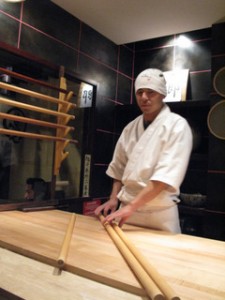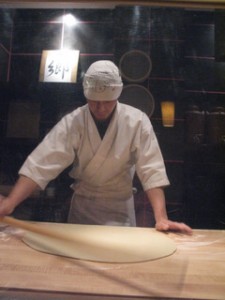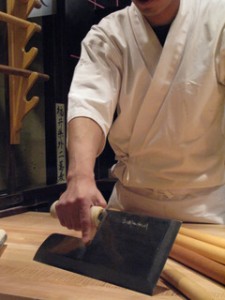I used own an udon noodle rolling pin that I purchased at my neighborhood Tokyo Hands (the Japanese version of Home Depot; some say that Home Depot patterened its business after Tokyo Hands that began in the early 1980s in Japan). I spent only 500 yen (about $5) for it. But the soba noodle rolling pins that Chef Kotani of Soba Totto in NYC uses are not such a cheap junk. Here I can show you his collection of rolling pins (menbo).
They are stored in this rack just to the right of his noodle-making station. Among these rolling pins he has favorites – one made of hiba (a kind of cypress) and the others made of asada wood from a tree similar characteristics to a cherry tree. All of the rolling pins are hand-made, and finished and polished with a carpenter’s pliers, not a sand paper. If you see and touch them you will recognize that they are truly art objects.
The hiba rolling pin has a slightly rough surface and is light, so it does a perfect job of rolling the dough into a very thin sheet down to 1/5mm thickness, says Chef Kotani. The asada rolling pin, on the other hand, is very hard and heavy. Its smooth surface resemble the surface of a polished marble counter top, so he uses this pin at the very end of rolling the dough to give it the most silky, flat surface. The rolling pins are quite long, about 3.6 to 4 feet in length, and 3cm (1.2 inches) in diameter when made. Chef Kotani has been using the hiba rolling pin for eight years. He showed it to me and explained that through use the diameter of the pin has shrunk to 2.5cm (1 inch) over time.
When Chef Kotani begins the rolling process the dough has a round disc shape. As he thins it out, Chef Kotani moves the edge from which he start to roll several times, so thaqt the round dough gradually becomes roughly square and finally to a completely perfect square shape. This is an amazing transition to see. The final thinned out dough resembles a smooth, fragile fabric.
His soba making station sits next to a yakitori station (chicken pieces on bamboo skewers grilled over Japanese bincho-tan charcoal) where dry air and some heat blows towards him. According to Chef Kotani this is not a perfect place to do his delicate work. As he rolls out the dough thinner, it dries out much quicker than doing it in a properly conditioned room. So, Chef Kotani moves swift and accurately with his-hop background music to complete the process.
The quality and variety of Japanese knives today are well known to the world of professional chefs and demanding avocational cooks. When it comes to soba knives, they are not much talked about yet. For cutting soba professionally one must use a knife specially made for the purpose.
This is Chef Kotani’s soba knife. The long blade is about 1 foot (33cm) in length. Using this knife the chef cuts the wide folded dough in one stroke. The knife weighs about 2 pounds (1.2 kg). The price is heafty – he spent about $1,000 for it eight years ago. The handle cover was hand-made – glued in place by him. After searchiong for materials for the grip – it should be comfortable to touch and stable for the grip – he found that shark’s skin also used for the grating for wasabi rhyzome was the best choice. With this knife Chef Kotani rhythmically cuts the folded dough into precisely 1.5mm wide strips – every strip is miraculously exactly 2mm …..perfection is his motto.
On my next blog I will post about soba-yu.








